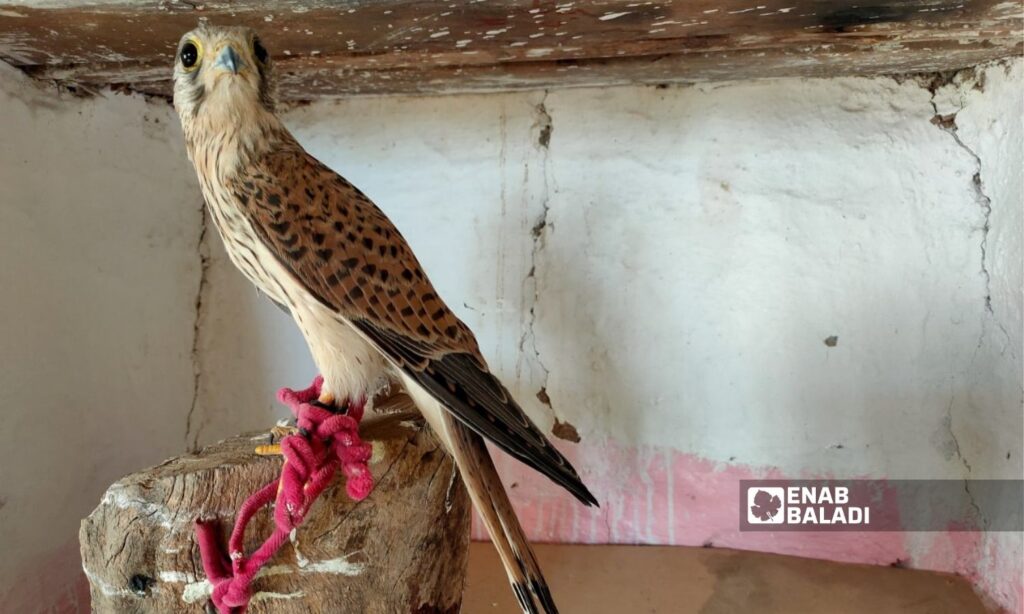Qamishli – Majd al-Salem
The 57-year-old Hamad al-Assaad examines his new binoculars with care in the southern countryside of the town of al-Qahtaniyah in the Qamishli region and neatly chooses the types of threads and wires from which he will make the net, which is placed on the back of a pigeon as bait for catching the Saker falcon, one of the most expensive types of birds in the Arab world.
Getting one of these birds is a dream for many hunting enthusiasts in the region. If you were lucky to get one of the good types of them, this means that you became a millionaire overnight. It is sustenance from heaven that God provides,” al-Assaad told Enab Baladi.
The man has been keen for years at this time each year to prepare well for the hunting season of Saker falcons or “al-Hurr falcons,” which extends for about three months, starting in mid-August.
Preparing for the hunting season needs a lot of equipment, starting from the daily means of transportation to the type of bait used in hunting, in a profession that al-Assaad inherited from his father and uncles, characterized by special rituals and atmospheres that are unique to the people of the region from others, and expressing their authentic Arab tribal customs.
Al-Assaad mobilizes all efforts for the annual trip every year, seeking to hunt Saker falcon again as he did in 2011. At the time, he sold it for one million Syrian pounds (about 20,000 USD) to buy a safari car that he uses on hunting trips until today.
Fun hobby but needs experience
For Alwan al-Hamid, 40, Saker falcon hunting is not only a “fun” hobby but also a source of livelihood.
Al-Hamid practices his hobby with a group of hunters on motorcycles. They set out with the sunrise every day and return at different times of the day, usually at sunset, as the temperatures drop and winter approaches.
Al-Hamid told Enab Baladi that he was ‘addicted’ to these hunting trips.
“We repeat it every day, and sometimes we sleep in the wilderness when trying to trap the Saker falcon when it descends to the ground at sunset without disturbing it so that it does not escape in the dark. Meanwhile, the hunters stay close to it, waiting for the sunrise to throw bait for it,” al-Hamid describes his hunting trip.
The hunter must be characterized by patience and the ability to observe for long periods, and to be aware of the behavior of the Saker falcon (Falco cherrug), the places it prefers to go to during its migration journey, the appropriate time to throw the bait and to be calm when catching the bird so as not to harm it or harm itself, according to al-Hamid.
Saker falcons prefer large swathes that are free of humans and far from cities and noise, especially the desert, as in the Syrian Badia.
Hunting experts say the experienced hunter should be calm with the Saker falcon after being caught since any injury or harm will lower its price.
Where do Saker falcons come from?
Abdul Bari Hassoun, 49, a hunter with a long history of tracking Saker falcons, told Enab Baladi that these species come with the approach of winter from the cold regions in Russia and Turkey in the north towards the warm regions in the south, on a journey of thousands of kilometers.
The Syrian airspace is one of its transit areas, especially the Syrian Jazira region, where hunters wait for them on their migration path at this time each year if they are lucky to hunt one of it, while the rest of the birds continue their way towards the warm south where they move individually and not as flocks of other birds.
The price of the bird varies according to its age, size and color, as there are black, blond, white, and red, and the larger its size and the white predominated it is, the more expensive it is, according to Hassoun.
“The prices of some birds may reach hundreds of thousands of dollars, bought mainly by citizens residing in the Arab Gulf region through local brokers,” he said.
Hassoun added that this authentic hobby has customs and habits that hunters know, including that what surrounds the place of the hunter’s stay at a distance of approximately one kilometer is considered “the sanctuary of his own hunting area,” so no other hunter may sleep near another hunter less than this distance.
In addition to that, the price of the Saker falcon is distributed to everyone who participated in the hunting process, even if they were “100 hunters”, the Saker falcon expert concluded.
Enab Baladi monitored dozens of Facebook pages active in the Syrian Jazira region, where hunting enthusiasts gather and exchange their skills, experiences, and diaries in the search for the Saker falcon (the free bird).

